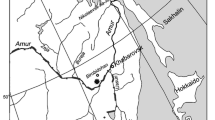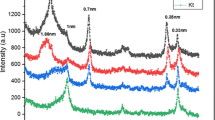Abstract
The goal of this paper is the characterisation of seven clays of the province of Alicante (SE Spain) and their possible use to improve the fertility, water absorption and contaminant-retaining capacity of degraded soils. Three soils affected by the dumping of construction debris were also studied to diagnose the problems and possible recovery strategies. Several physicochemical properties were measured, such as the water holding capacity, soil organic matter, lime, pH, EC and CEC. A high correlationship between mineralogical and elemental composition was obtained. Illite was present in all clays and soils. Some of the samples also contained kaolinite and significant amounts of lime. The CEC, as expected, was more closely related to the organic matter content. Soil organic matter was detected in the second derivative of the FTIR spectra by the signals of the CH2 groups at 2850 and 2919. This way, the FTIR spectrum for the soils of the area would make it possible to estimate both the organic matter content and the CEC. Despite their origin, soils did not show heavy metal pollution; however, salinisation risk seemed to be the most probable cause of degradation. According to the organic matter, lime and illite content, two clays were selected as the most suitable for soil degradation recovery. Furthermore, organic matter additions may help to improve the self-depurative ability of the soil.




Similar content being viewed by others
Data availability
Data are available on request from the authors.
References
Alamgir, M. (2016). The effects of soil properties to the extent of soil contamination with metals. In H. Hasegawa, I. M. M. Rahman, & M. A. Rahman (Eds.), Environmental remediation technologies for metal-contaminated soils. (pp. 1–19). Springer.
Bower, C. A., Reitemeier, R. F., & Fireman, M. (1952). Exchangeable cation analysis of saline and alkali soils. Soil Science, 73, 251–261.
Campillo-Cora, C., Conde-Cid, M., Arias-Estévez, M., Fernández-Calviño, D., & Alonso-Vega, F. (2020). Specific adsorption of heavy metals in soils: Individual and competitive experiments. Agronomy, 10(8), 1113–1134.
Castrillo, N., Mercado, A., & Volzone, C. (2018). Influencia del calcio en la retención de humedad por arcilla. Matèria, 23(2), e-12098.
Choo, H., Song, J., Lee, W., & Lee, C. (2016). Effects of clay fraction and pore water conductivity on electrical conductivity of sand-kaolinite mixed soils. Journal of Petroleum Science and Engineering., 147, 735–745.
Darban, A. K., Foriero, A., & Yong, R. N. (2000). Concentration effects of EDTA and chloride on the retention of trace metals in clays. Engineering Geology, 57(1–2), 81–94.
De Matos, A. T., Fontes, M. P., da Costa, L. M., & Martinez, M. A. (2001). Mobility of heavy metals as related to soil chemical and mineralogical characteristics of Brazilian soils. Environmental Pollution, 111(3), 429–435.
Echeverría, J. C., Churio, E., & Garrido, J. J. (2002). Retention mechanisms of Cd on illite. Clays and Clay Minerals, 50(5), 614–623.
Gu, S., Kang, X., Wang, L., Lichtfouse, E., Wang, C. (2019). Clay mineral adsorbents for heavy metal removal from wastewater: A review. Environmental Chemistry Letters, Springer, 17(2):629–654.
Hou, S., Zheng, N., Tang, L., Ji, X., Li, Y. (2019). Effect of soil pH and organic matter content on heavy metals availability in maize (Zea mays L.) rhizospheric soil of non-ferrous metals smelting area. Environmental Monitoring and Assessment (191), Article number: 634.
Jordá, J. D., Jordán, M. M., Ibanco-Cañete, R., Montero, M. A., Reyes-Labarta, J. A., Sánchez, A., & Cerdán, M. (2015). Mineralogical analysis of ceramic tiles by FTIR: A quantitative attempt. Applied Clay Science, 115, 1–8.
Jung, W. K., Kitchen, N. R., Sudduth, K. A., Kremer, R. J., & Motavalli, P. (2005). Relationship of apparent soil electrical conductivity to claypan soil properties. Soil Science Society of America Journal, 69(3), 883–892.
Lafuente, B., Downs, R. T., Yang, H., & Stone, N. (2015). The power of databases: The RRUFF project. In T. Armbruster & R. M. Danisi (Eds.), Highlights in mineralogical crystallography. (pp. 1–30). W. De Gruyter.
Lundy, L., Alves, I., Revitt, M., & Wildeboer, D. (2017). Metal water-sediment interactions and impacts on the ecosystem. International Journal of Environmental Research and Public Health, 14, 722–733.
Masindi, V., & Muedi, K. L. (2018). Environmental contamination by heavy metals. In H. E. D. M. Saleh & R. F. Aglan (Eds.), heavy metals. (pp. 115–133). In Tech.
Micó, C., Peris, M., Sánchez, J., & Percatalá, L. (2008). Trace element analysis via open-vessel or microwave-assisted digestion in calcareous Mediterranean soils. Communications in Soil Science and Plant Analysis, 39(5–6), 890–904.
Miranda-Treviño, J. C., & Coles, C. A. (2003). Kaolinite properties, structure and influence of metal retention on pH. Applied Clay Science, 23, 133–139.
Muththalib, A.; Baudet, B.A. 2019. Effect of heavy metal contamination on the plasticity of kaolinbentonite clay mixtures and an illite-smectite rich natural clay. E3S Web of Conferences 92, 10005 S-Glasgow 2019
Namieśnik, J., & Rabajczyk, A. (2010). The speciation and physicochemical forms of metals in surface waters and sediments. Chemical Speciation & Bioavailability, 22(1), 1–24.
Navarro- Pedreño, J., Almendro-Candel, M. B., Gómez-Lucas, I., Jordán, M. M., Bech, J., & Zorpas, A. A. (2018). Trace metals content and availability of essential metals in agricultural soils of Alicante (Spain). Sustainability, 10(4534), 1–11.
Plekhanova, I. O. (2017). Self-purification of agrosoddy-podzolic sandy loamy soils fertilized with sewage sludge. Eurasian Soil Science., 50, 491–497.
Reig, F. B., Adelantado, J. G., & Moreno, M. M. (2002). FTIR quantitative analysis of calcium carbonate (calcite) and silica (quartz) mixtures using the constant ratio method. Application to Geological Samples. Talanta, 58(4), 811–821.
Ruiz-Ortiz, P. A., Castro, J. M., Arias, C., Vilas, L., Martín-Chivelet, J., de Gea, G. A., Molina, J. M., Nieto, L. M., Reolid, M., Aguado, R., Quijano, M. L., & Coruña, F. (2019). The South Iberian Continental margin. The geology of Iberia: A geodynamic approach the alpine cycle. In C. Quesada & J. T. Oliveira (Eds.), Regional geology reviews. (Vol. 3, pp. 190–205). Cham: Springer.
Sánchez-Sánchez, A., Cerdán, M., Jordá, J. D., Amat, B., & Cortina, J. (2019). Characterization of soil mineralogy by FTIR: Application to the analysis of mineralogical changes in soils affected by vegetation patches. Plant and Soil, 439(1–2), 447–458.
Takáč, P., Szabová, T., Kozáková, L., & Benková, M. (2009). Heavy metals and their bioavailability from soils in the long-term polluted Central Spiš region of SR. Plant, Soil and Environment, 55(4), 167–172.
Funding
No funding application.
Author information
Authors and Affiliations
Contributions
JJ and MMJ were involved in conceptualisation and methodology; JJ and AS were involved in validation; PJ, MC and JET were involved in formal analysis and data curation; JET, JJ and MMJ were involved in writing—original draft preparation; MMJ was involved in writing—review and editing; and JJ was involved in supervision.
Corresponding author
Ethics declarations
Conflict of interest
The authors declare no conflict of interest.
Additional information
Publisher's Note
Springer Nature remains neutral with regard to jurisdictional claims in published maps and institutional affiliations.
Rights and permissions
About this article
Cite this article
Jordá, J.D., Tent-Manclús, J.E., Cerdán, M. et al. Characterisation of clays from Alicante province (SE Spain) for use in the recovery of degraded soils. Environ Geochem Health 44, 247–255 (2022). https://doi.org/10.1007/s10653-021-00925-y
Received:
Accepted:
Published:
Issue Date:
DOI: https://doi.org/10.1007/s10653-021-00925-y




